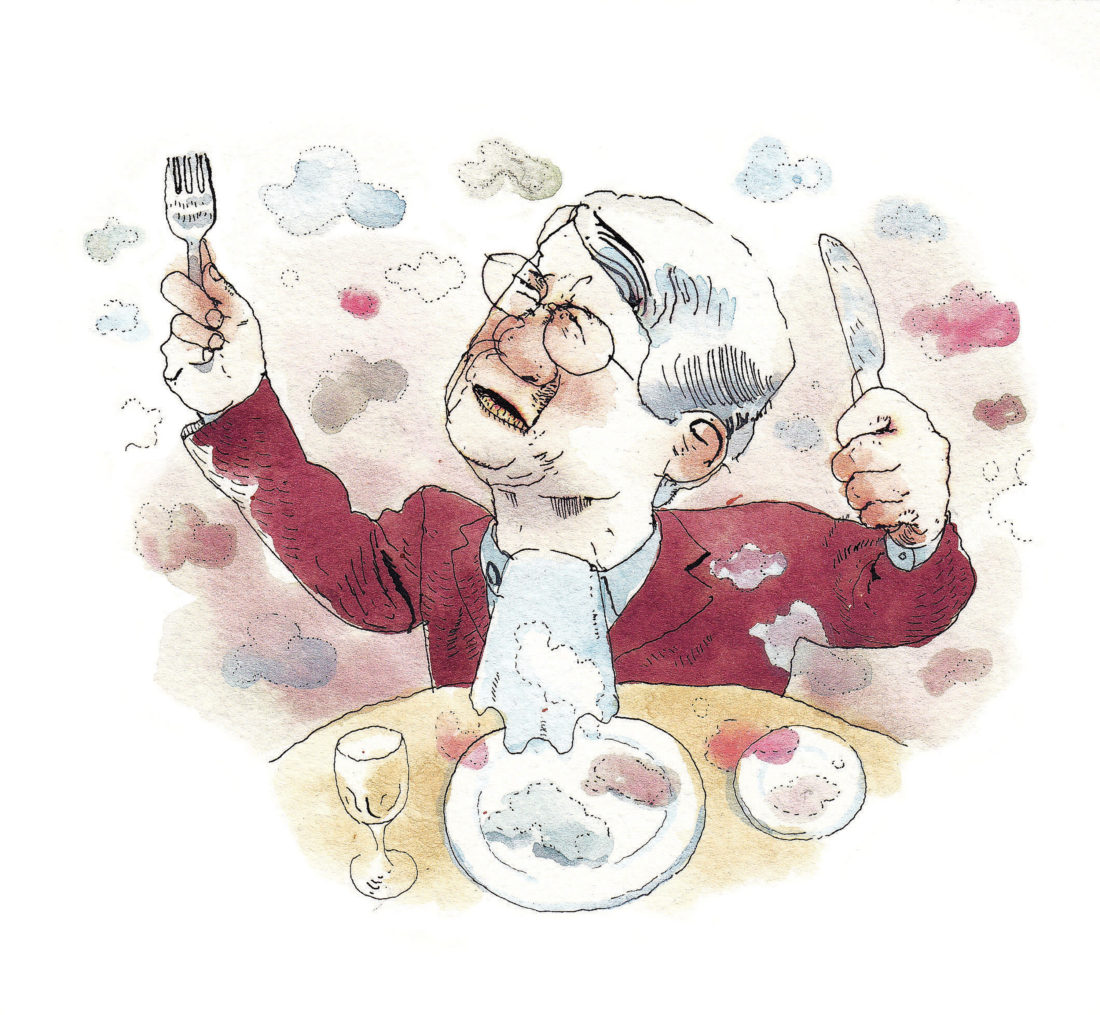I remember reading, with a jolt, this headline in the New York Times:
“American Cuisine Is Back.”
I was eating a chicken potpie. “Where are you back from?” I asked it. No response. A chicken potpie is not a fun food. And I mean that as a compliment.
You know that expression on a dog’s face as he watches you plop food into his bowl? Everything that’s happened in my life so far has led up to this moment. That is how I feel, at bottom, about something to eat.
It’s hard to turn me away from food. “Trust me,” confided a waitperson once, “don’t eat the garnish.” And yet I had a hard time laying off that carrot curl. I don’t eat a lot of carrots, but an occasional carrot shaving… Maybe management made her say that so they wouldn’t have to keep buying new carrots. Now on the Internet you can find Rachel Maddow, the MSNBC news host, saying, “Don’t eat the garnish” with regard to cocktail olives and maraschino cherries. Honeybees, she says, have been turning a fluorescent red from sipping out of maraschino cherry vats. I’ll cut out the cherries when I start getting rosy cheeks. Cocktail olives, she says, have “conceivably been lying out festering in their own juices in a warm room all night, with fingers on them.” But isn’t gin a disinfectant?
Silliness, alone, needn’t put me off food. Someone told me she had recently enjoyed celery sorbet. Celery Sorbet sounds like the name of an exotic dancer. If served it, however, I would try it. If it tasted okay, I would say so.
What I will not eat is foam. Certain restaurants in recent years have been serving bacon foam. Ham froth. Mushroom foam. Culinary foam is made of thoroughly strained (I’ll say) juice from the food in question (mushroom juice? Don’t ask me) mixed with gelatin and foo-fooed up with nitrous oxide. You know that stuff you see on leaves in the woods, called cuckoo spit? That’s what culinary foam looks like. You can tell it’s not mildew because if you don’t eat it right away, it turns into a gooey spot. It’s like the belch of someone who ate bacon, captured atop your entrée. It was invented by a Spanish chef named Ferran Adrià, whose restaurant, El Bulli, was five times voted the best in the world. “Molecular gastronomy,” Adrià’s work was called. Breaking ingredients down to their quarks and neutrinos. Now El Bulli has closed; it plans to reopen not as a restaurant but as a think tank, a “creativity center.”
A creativity center is to an eatery as a a credit default swap is to a roll of fifties, and as bacon foam is to bacon. I don’t say cuisine must cater to people with teeth. I will eat (if eat is the word) crystal-clear consommé. I do get wistful, knowing at a glance there will be no chewing here. Oyster crackers, I’m thinking, would sure go good with this. Dipping into pure clear soup is even a little spooky, like being the first one off the high dive in the morning, when the water’s so unruffled you can’t see how far down in the air it starts. (I once saw a lunch-counter sign, “Today’s Soup: Calm Chowder.” You’d feel bad about stirring it.) Don Kelly of the Detroit Tigers, primarily an infielder, says this about playing a few innings at catcher: “The strangest thing is when you go to catch the ball and they hit it, and there’s nothing there.” Biting into foam must be like that.
“I like grits,” Chet Atkins used to say, “because they have no bones.” I take his point. But instant grits—no. Too close to grit foam. You don’t want grits to grate, but however near-fluffy they’ve been cooked down to, they should retain a gritty gist.
On one of his comedy records back in the seventies, Jerry Clower came down hard on those frozen biscuits that come in tubes. All over town, every morning, Whop, Whop, you could hear those tubes being broken open, he said—even though “them biscuit,” as Clower put it so well, “ain’t fit to eat.” Like trying to chew on a toothpick made of composition board: no grain. More recently, certain brands have discovered how to freeze patties of biscuit dough that when baked actually come out a lot like biscuits. I say gastronomic science should trend in that direction. Not toward breaking food down further and further. That’s my job.








